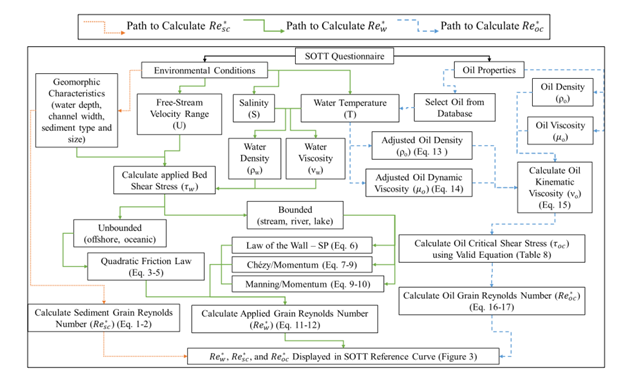Sunken Oil Transport Tool (SOTT)
Sunken Oil Transport Tool

Authors: Melissa Gloekler, Ph.D. & Nancy Kinner, Ph.D.
Using experimentally derived oil transport equations, a prototype sunken oil transport tool (SOTT) was developed to predict sunken oil transport in a current driven environment. All flume-based experiments were conducted in the MacFarlane Flume, at the University of New Hampshire’s (UNH) Coastal Response Research Center (CRRC). For a thorough review, instructions on how to use the SOTT, and for specific equations, the user is referred to Chapters 3 and 4 of Gloekler (2021).
Experimental results used to develop the SOTT were conducted using sunken No. 6 heavy fuel oil mixed with kaolinite clay and are valid for current-driven flow regimes with uniform, steady state conditions. Based on those mesoscale studies, the driving factors used to predict sunken oil transport are the oil’s kinematic viscosity (v_o) and the median sediment size (d_50). The stages of oil transport were characterized based on v_o, and empirical relationships using v_o and d_50 were derived to predict the oil’s critical shear stress (CSS). For v_o< 2x104 cSt, thresholds of movement were defined as: (1) gravity dispersion, (2) rope formation, (3) ripple formation, and (4) break-apart/resuspension. For v_o > 6x104 cSt, the stages include: (1) type II erosions, and (2) bedload transport. For further information and representative images of the stages of sunken oil transport the user is referred to the Sunken Oil Catalogue.
In the event of a non-floating oil spill, responders can input the spilled oil’s characteristics (i.e., density, viscosity) and in-situ environmental conditions (e.g., water velocity, temperature, sediment type) into the SOTT to evaluate if oil will transport along the bottom, resuspend into the water column, or be buried by sediments (Figure 1). SOTT results are presented in the form of a reference curve and summary tables so that responders can predict if oil may be transported along the bottom, resuspended into the water column, or buried by sediments. SOTT results could help inform placement of response assets, evaluate relevant response techniques (e.g., poling operations, water column snare/pom-pom configurations), and direct where responders look for the sunken oil (e.g., downstream, where the oil sank).
Reference:
Gloekler, M.D., "DEVELOPMENT OF A SUNKEN OIL TRANSPORT TOOL USING MESOSCALE EXPERIMENTS" (2021). Doctoral Dissertations. 2571.
https://scholars.unh.edu/dissertation/2571
-
expand_more library_books References (1)
- Melissa Gloekler, Ph.D. , Development of a sunken oil transport tool using mesoscale experiments
-
expand_more cloud_download Supporting documents (1)Product brochureSunken Oil Transport Tool (SOTT).pdfAdditional files may be available once you've completed the transaction for this product. If you've already done so, please log into your account and visit My account / Downloads section to view them.